Major 7th chords (often written as maj7) add a sophisticated and lush dimension to your guitar playing. They are a step beyond basic major chords, injecting a layer of complexity and emotion that can elevate your music. If you’re looking to enrich your chord vocabulary and understand how to use these beautiful chords, you’ve come to the right place. In this guide, we’ll explore the theory behind major 7th chords, learn essential shapes across the fretboard, and discover how to effectively use them in your guitar progressions.
What Exactly is a Major 7th Chord? Delving into Music Theory
To truly appreciate major 7th chords, let’s understand their construction. At their core, major 7th chords are built upon the foundation of a major triad. A major triad is comprised of three notes: the root (1), the major third (3), and the perfect fifth (5) of a major scale. For example, a C major triad consists of C (root), E (major 3rd), and G (perfect 5th).
Now, where does the “major 7th” come in? It refers to the major seventh interval added to this triad. Think of an interval as the distance between two notes. A major seventh interval is positioned just one semitone (or one fret on the guitar) below the root note an octave higher. In the key of C, the major 7th interval from C is B. So, a C major 7th chord (Cmaj7) is composed of the notes C (1), E (3), G (5), and B (major 7th).
Listen to the sonic difference between a standard C major triad and a Cmaj7 chord. You’ll immediately notice the added richness and harmonic color that the major 7th brings.

The diagram above illustrates open major triad shapes, which are the building blocks for understanding major 7th chords.
Essential Major 7th Chord Shapes for Guitar
The good news is that transitioning from major chords to major 7th chords on guitar is often a subtle adjustment. Many major 7th shapes are derived from familiar major chord shapes, requiring only a slight modification to incorporate the major 7th interval.
Let’s explore some fundamental major 7th chord shapes in both open and movable positions. Understanding these shapes will allow you to play major 7th chords in various keys and positions across the guitar neck.
Open Position Major 7th Chords
Open position chords are played utilizing open strings, making them foundational for beginner and intermediate guitarists. Here are some common open major 7th shapes and their relationship to open major triads:
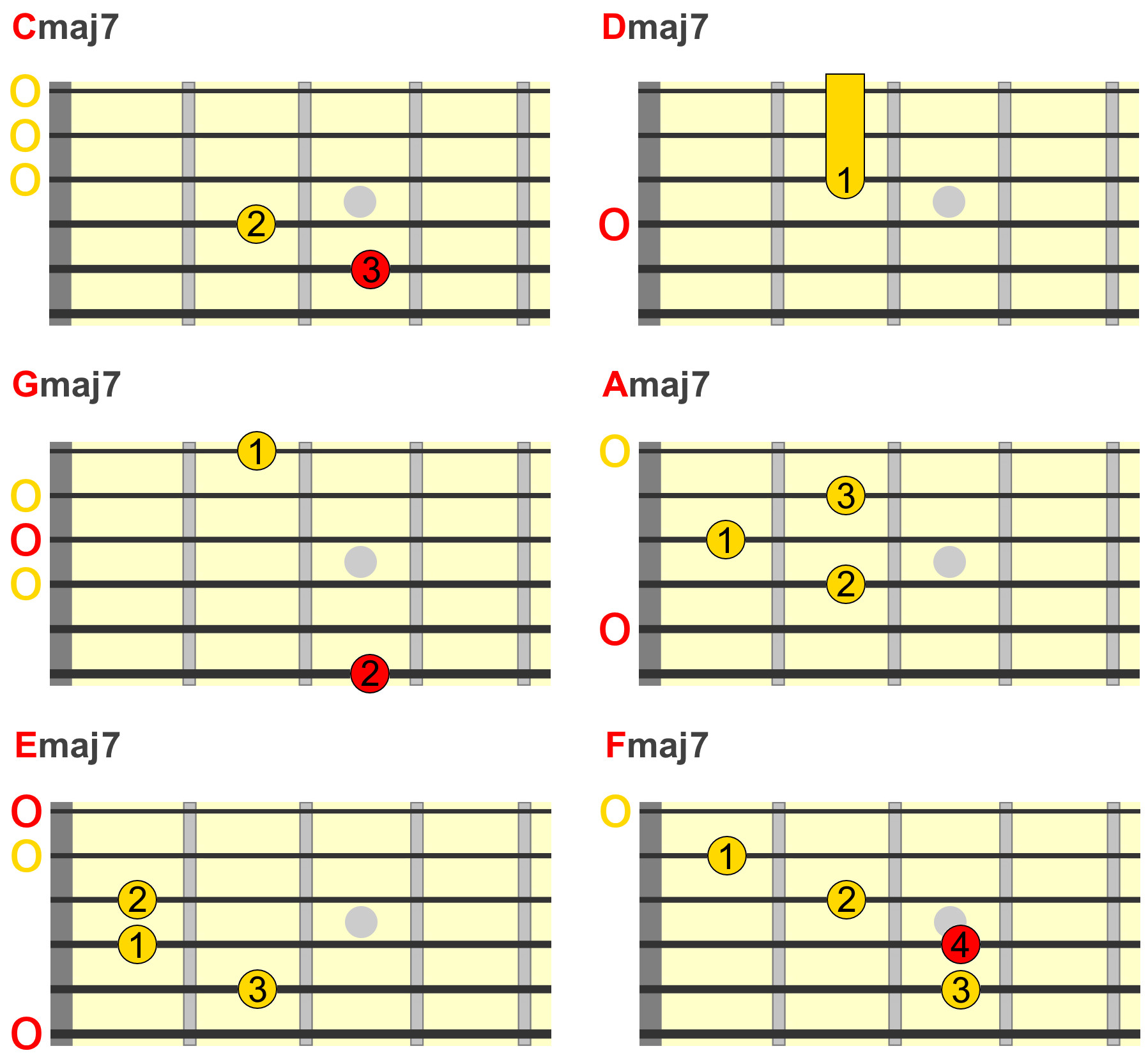
This image displays common open major 7th chord shapes. Notice how they are visually similar to open major triads, with a slight alteration to create the major 7th sound. The red dots and “O” symbols indicate the root notes within each shape.
By comparing the open major triad shapes with the open major 7th shapes, you can visually grasp how the major 7th interval is introduced. Practice switching between a major chord and its major 7th counterpart on the same root to train your ear to the distinct sound of the added major 7th. For instance, try moving between D major and Dmaj7, or G major and Gmaj7 in open position.
Movable Major 7th Chord Shapes
Movable chord shapes are invaluable as they allow you to play the same chord voicing in different keys simply by shifting the shape up or down the fretboard. These shapes are typically based on barre chords or partial barre chords.
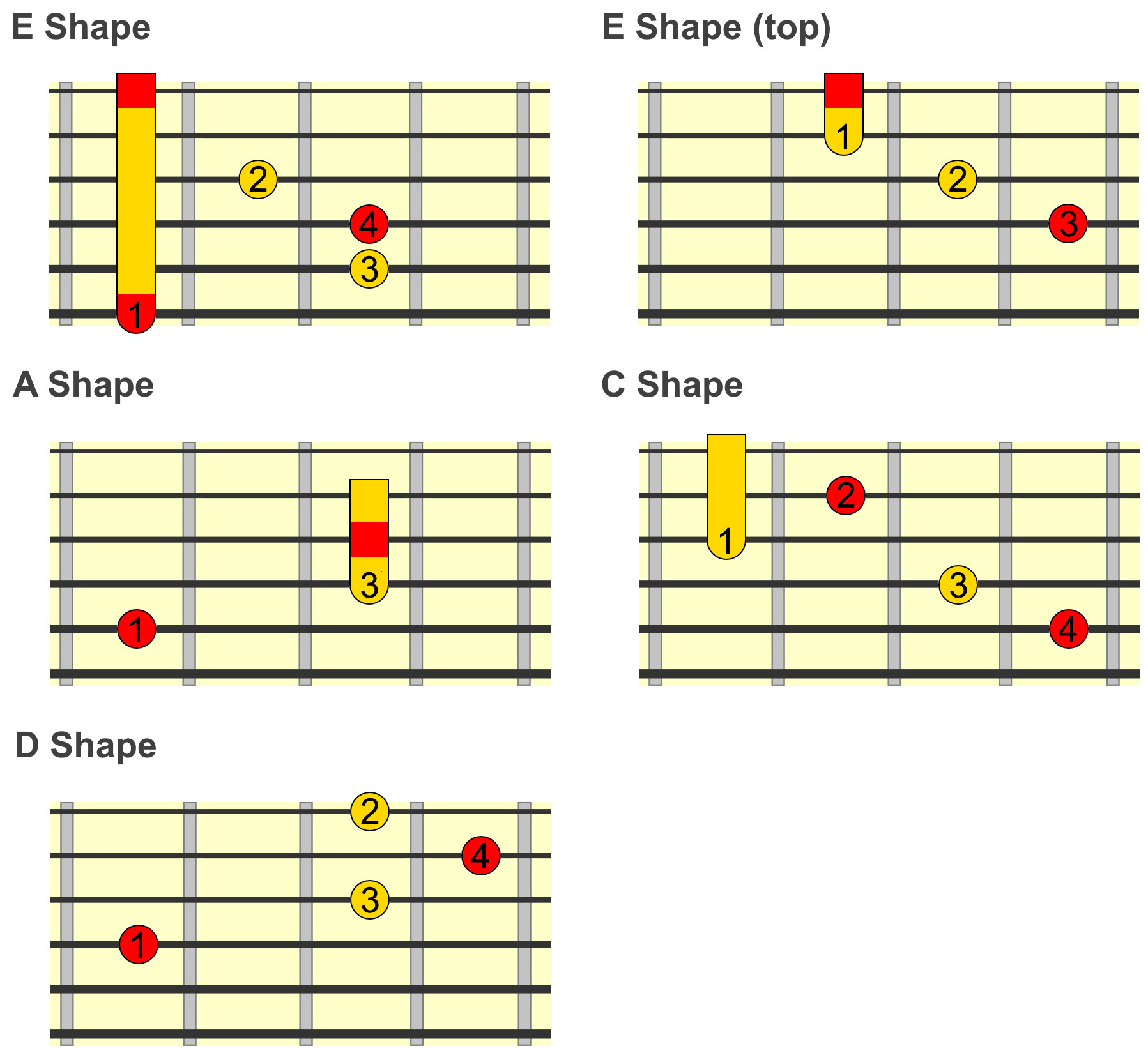
These are the basic movable triad shapes from which we will derive our movable major 7th shapes. Understanding these triad shapes is crucial for grasping the major 7th variations.
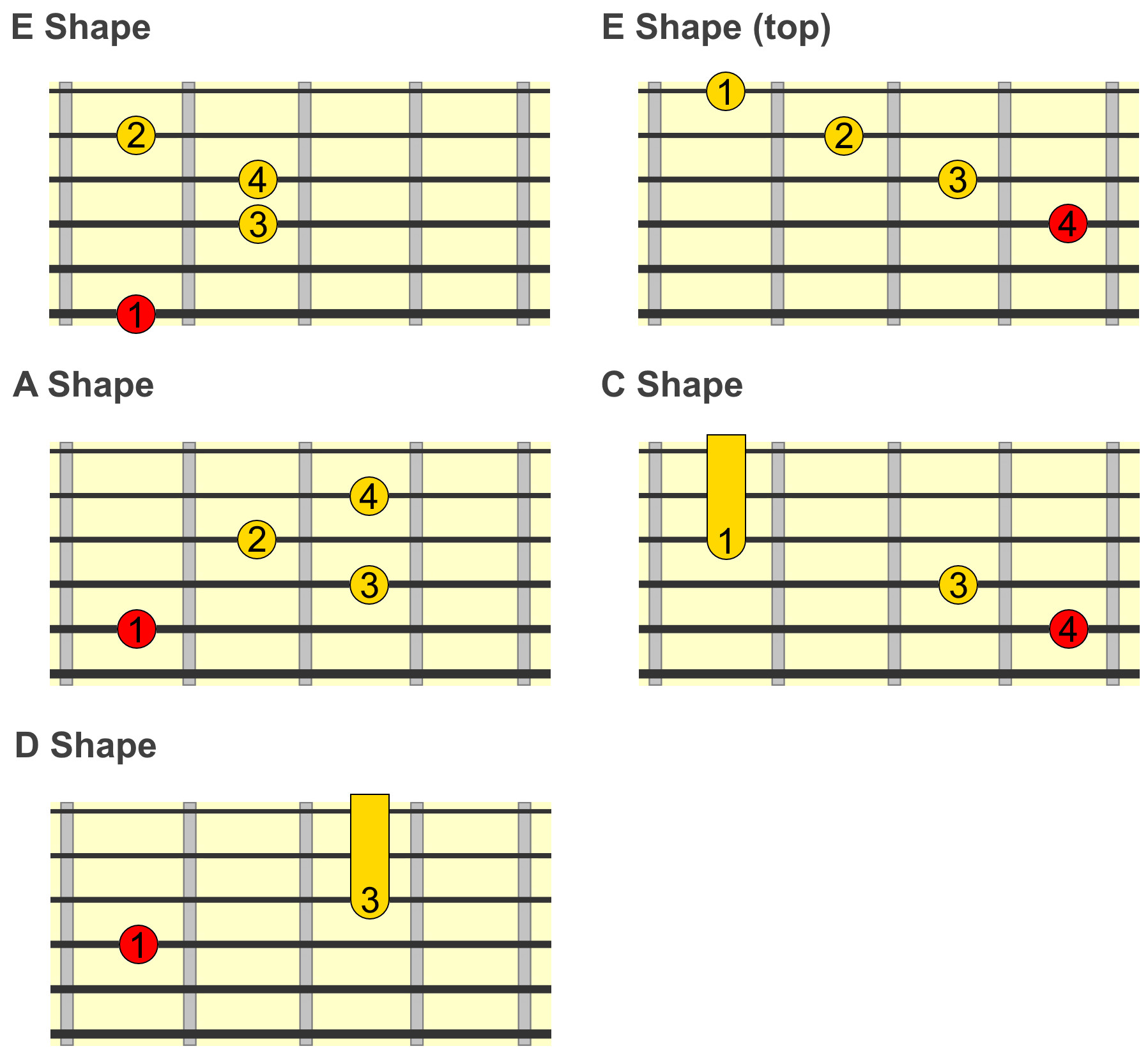
Here are movable major 7th chord shapes derived from the triad shapes shown previously. The root note is indicated, allowing you to position the shape correctly on the fretboard to play the desired major 7th chord. Practice moving these shapes up and down the neck, ensuring the root note is on the correct fret for different keys. For example, to play an Fmaj7, position the root of the shape on the 1st fret of the E string.
Incorporating Major 7th Chords into Your Music
Major 7th chords are not just theoretical constructs; they are incredibly useful tools for adding depth and sophistication to your guitar playing. Understanding where they naturally occur in musical contexts will help you integrate them effectively.
Major 7th chords have a natural home within both major and minor key progressions. They often appear on specific degrees of the scale, creating characteristic harmonic colors.

This table illustrates where major 7th chords naturally occur in major and minor keys when harmonizing the scales. This is a valuable guide for understanding typical uses of maj7 chords in music.
Let’s look at some common examples:
The Tonic (I) Chord in Major Keys
In major keys, the tonic chord (the chord built on the 1st degree of the scale) is very often a major 7th chord. This gives the “home” chord of the key a richer, more complete sound. For example, in the key of G major, you might often hear a Gmaj7 used as the tonic chord instead of a simple G major.
You can also create interesting harmonic movement by alternating between a major triad and a major 7th chord on the tonic. This subtle shift adds a touch of color and variation.
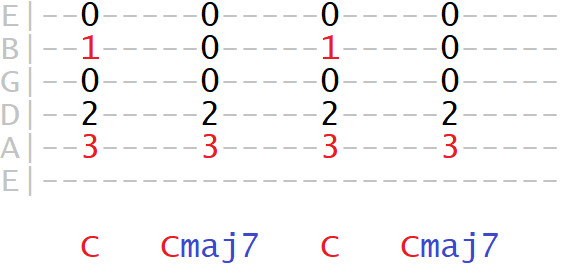
This example progression in C major demonstrates the movement between a C major triad and a Cmaj7 chord, highlighting the subtle but effective harmonic color change.
The IV Chord in Major Keys
The IV chord, also known as the subdominant, is another common place to find major 7th chords in major keys. Using a maj7 on the IV chord adds a smooth, jazzy feel to the progression. In the key of C major, the IV chord is F, and using an Fmaj7 instead of F major creates a more sophisticated harmonic landscape.
The III Chord in Minor Keys
In minor keys, the III chord (built on the 3rd degree of the minor scale) is frequently a major 7th chord. In the key of A minor, the III chord is C, so a Cmaj7 is a natural and beautiful choice in this context.
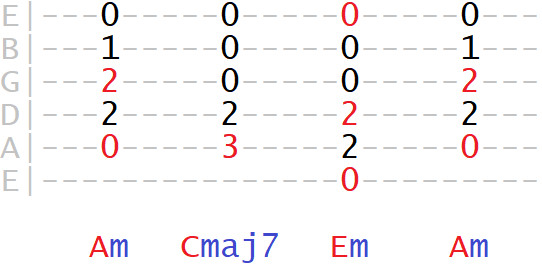
This progression in A minor shows the use of Cmaj7 as the III chord, demonstrating its natural fit and harmonic richness within a minor key context.
The VI Chord in Minor Keys
Similarly, the VI chord in minor keys can also be a major 7th chord. In the key of E minor, the VI chord is C, making Cmaj7 another viable and interesting option.
This E minor progression showcases Cmaj7 as the VI chord, again highlighting the smooth and colorful quality that major 7th chords bring to minor key progressions.
Trust Your Ear: The Ultimate Guide
While understanding the theory and common uses of major 7th chords is valuable, remember that music is ultimately about sound and feeling. Don’t be afraid to experiment and use major 7th chords wherever they sound good to your ear, even outside of these typical contexts.
The guidelines discussed here provide a solid foundation, but your own musical intuition is the most important tool. Explore different voicings, experiment with progressions, and let your ear guide you. As you become more familiar with the sound and feel of major 7th chords, you’ll naturally begin to incorporate them into your playing in creative and expressive ways.
In our next exploration, we’ll delve deeper into more advanced techniques for using major 7th chords in progressions and explore chord extensions to further expand your harmonic palette. Keep practicing and listening, and you’ll unlock even more of the magic that major 7th chords can bring to your guitar playing!

